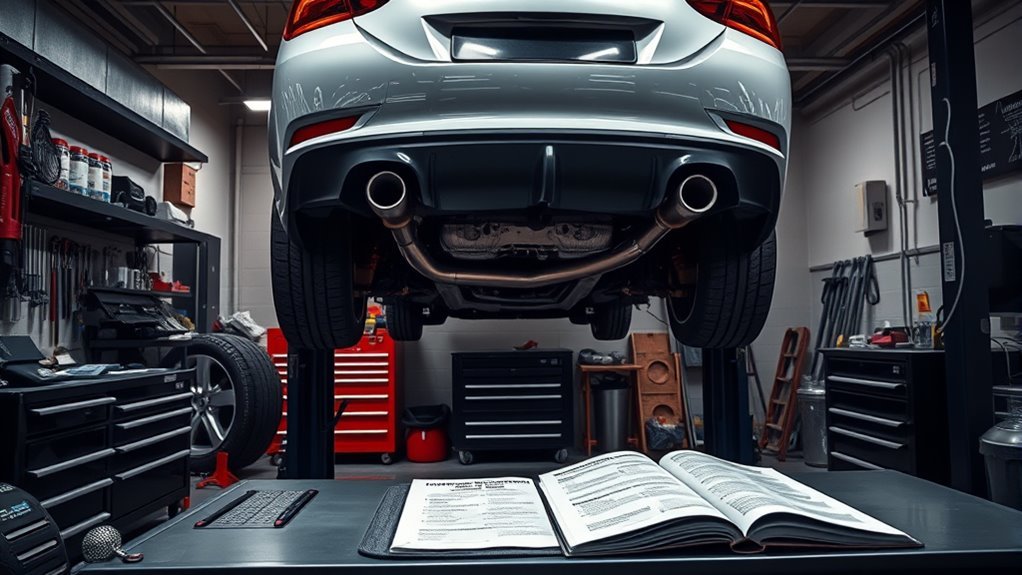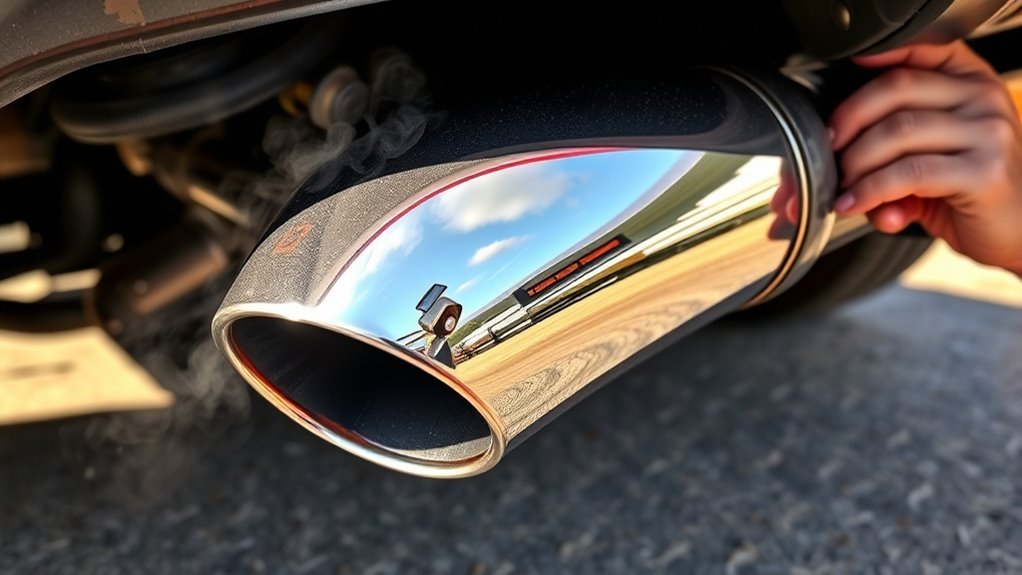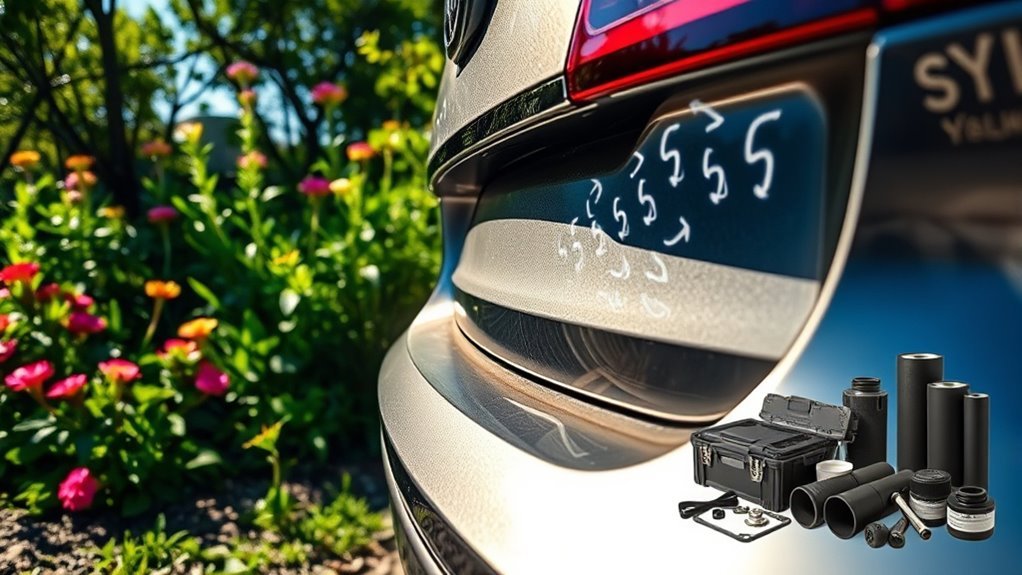To get rid of exhaust drone, first identify its frequency using a sound analyzer. Inspect your exhaust for leaks or damage, and consider upgrading to chambered or turbo mufflers designed to cancel specific frequencies. Adding resonators along pipes targets low-frequency drones, while adjusting pipe length and diameter shifts unwanted sounds. Soundproof your cabin with mass-loaded vinyl and foam to reduce vibration noise. Regular maintenance prevents recurrence. Explore these tips to optimize your vehicle’s quietness and performance.
What Causes Exhaust Drone in Vehicles

Although it might seem like just an annoyance, exhaust drone occurs when specific sound frequencies resonate within your vehicle’s exhaust system, creating a constant, low-frequency vibration that you can feel and hear inside the cabin. This phenomenon stems from the interaction between exhaust acoustics and engine vibrations. As exhaust gases exit the engine, they generate pressure waves that reflect and amplify within the exhaust pipes. When these waves align with particular frequencies related to engine RPM, they produce standing waves, causing the drone. The design and length of your exhaust components greatly influence these resonant frequencies. Understanding this interplay is essential because exhaust drone not only disrupts your driving experience but also signals inefficiencies in your vehicle’s acoustic system, which you can address to reclaim the freedom of a smooth, vibration-free ride.
Identifying the Frequency and Intensity of the Drone

To effectively address exhaust drone, you need to identify its pitch by listening carefully or using a frequency analyzer app. Measuring the sound intensity with a decibel meter will help quantify the noise level. Finally, pinpoint the exact location of the drone within the exhaust system to target the source accurately.
Detecting Drone Pitch
Identifying the pitch of an exhaust drone requires measuring the frequency and intensity of the sound accurately. To detect drone pitch, use a sound analyzer or smartphone app that performs real-time pitch analysis. Focus on the dominant drone frequency, usually between 50-300 Hz, which causes that annoying vibration. Pinpointing this frequency is essential for effective noise reduction.
| Parameter | Typical Range |
|---|---|
| Drone Frequency | 50 – 300 Hz |
| Pitch Intensity | Variable, dB level |
| Detection Tool | Sound Analyzer App |
Measuring Sound Intensity
When measuring sound intensity, you’ll need accurate tools like a decibel meter or a calibrated smartphone app to capture both the frequency and amplitude of the exhaust drone. Start by positioning the device near the suspected noise source while the engine runs at a consistent RPM. Conduct thorough sound measurement by recording decibel levels over time, noting peak and average values. Utilize audio analysis software to identify the dominant frequency of the drone, which helps in distinguishing it from other engine sounds. This precise data enables you to understand the drone’s characteristics, essential for effective mitigation. By quantifying both intensity and frequency objectively, you gain control over the process, empowering you to take targeted steps toward eliminating the exhaust drone and reclaiming your ride’s freedom from unwanted noise.
Locating Noise Source
Having measured the sound intensity and frequency, you now need to pinpoint the exact location of the exhaust drone within the system. Accurately locating this noise source is essential for effective exhaust modifications and achieving ideal noise reduction. Use these practical steps:
- Employ a handheld frequency analyzer to scan along the exhaust path.
- Listen for consistent tonal peaks indicating drone frequency.
- Isolate sections by temporarily disconnecting or covering segments.
- Use vibration sensors to detect resonance points on pipes or mufflers.
- Compare measurements before and after each test to confirm the drone’s origin.
Inspecting Your Exhaust System for Damage or Leaks

Although exhaust drone often originates from internal issues, inspecting your exhaust system for damage or leaks is essential to pinpoint external causes. Begin system inspections by visually examining the entire exhaust pathway, focusing on joints, clamps, and welds for cracks or rust. Use a flashlight to spot any black soot marks, which often indicate exhaust leaks. Next, perform a hands-on check by gently tapping components to detect loose parts causing vibration noise. You can also listen for unusual hissing sounds while the engine runs, signaling potential leaks. Don’t forget to inspect heat shields, as damaged or loose shields may amplify drone. Prioritizing thorough system inspections helps you isolate exhaust leaks early, keeping your vehicle’s noise levels controlled and preserving your driving freedom without disruption.
Replacing or Upgrading Mufflers to Reduce Noise
Since mufflers play an essential role in dampening exhaust noise, replacing or upgrading them can greatly reduce exhaust drone. Choosing the right muffler type is key to effective noise reduction while maintaining performance. Consider these points when upgrading:
- Chambered mufflers: Utilize internal chambers to cancel sound waves, ideal for moderate noise reduction.
- Straight-through (performance) mufflers: Offer minimal restriction but less noise reduction; better for power and sound balance.
- Turbo mufflers: Use curved perforated tubes for smooth airflow and effective drone reduction.
- Material choice: Stainless steel mufflers resist corrosion and maintain noise control longer.
- Fit and installation: guarantee proper fitment to avoid leaks that amplify drone.
Adding Resonators to Cancel Out Unwanted Sounds
You’ll want to position resonators strategically along the exhaust pipe to target specific drone frequencies effectively. Choosing the correct resonator size is essential, as it must match the exhaust diameter and desired frequency cancellation range. Proper placement and sizing work together to neutralize unwanted sound waves without restricting exhaust flow.
Resonator Placement Tips
When aiming to reduce exhaust drone, strategically placing resonators is crucial for maximizing sound cancellation. Understanding resonator types and installation techniques helps you position them where they counteract specific sound frequencies effectively.
Keep these resonator placement tips in mind:
- Install resonators close to the engine to target low-frequency drone.
- Use multiple resonators spaced along the exhaust pipe to broaden cancellation range.
- Position resonators before bends or mufflers to disrupt sound waves efficiently.
- Guarantee secure mounting to prevent vibration-induced noise.
- Match placement to resonator type for ideal frequency tuning.
Resonator Size Selection
Although resonator placement is essential, selecting the correct resonator size is equally important for effectively canceling unwanted exhaust sounds. Your choice depends on resonator types, materials, and the specific frequencies you want to target. Larger resonators absorb lower frequencies better, while smaller ones handle higher frequencies. Resonator materials like stainless steel offer durability and consistent sound attenuation. Use the table below to quickly match resonator size with expected frequency range and common materials:Resonator SizeFrequency Range (Hz)Common Resonator Materials
Pick a resonator size that aligns with your exhaust drone frequency for ideal sound cancellation.
Using Sound-Deadening Materials in the Vehicle Cabin
Since exhaust drone is largely a low-frequency vibration transmitted through the vehicle’s structure, employing sound-deadening materials inside the cabin can greatly reduce its impact. To effectively address this, focus on soundproofing techniques and material selection that target vibration damping and noise absorption. Here’s what you should consider:
Exhaust drone stems from low-frequency vibrations; sound-deadening materials inside the cabin significantly lessen its effect.
- Use mass-loaded vinyl (MLV) on door panels and floorboards to block sound waves.
- Apply closed-cell foam to absorb mid-range frequencies and reduce resonance.
- Install butyl rubber mats beneath carpets for vibration isolation.
- Seal gaps and seams with acoustic sealant to prevent noise leakage.
- Cover the roof liner with sound-absorbing fabric to minimize airborne drone.
Checking and Adjusting Exhaust Pipe Length and Diameter
If you want to effectively reduce exhaust drone, you’ll need to carefully check and adjust your exhaust pipe’s length and diameter. These dimensions directly influence sound wave reflections and resonances within your system. Start by measuring your current pipe length and diameter, noting how they align with your vehicle’s exhaust configurations. Shorter pipes or larger diameters often shift drone frequencies, while longer or narrower pipes can dampen them. Make precise pipe modifications by cutting or replacing sections to alter these parameters, aiming to disrupt standing waves that cause drone. Use quality materials and guarantee airtight connections to maintain performance and reliability. By methodically tuning pipe length and diameter, you gain control over exhaust acoustics, enhancing your driving freedom without unwanted noise distractions.
Considering Professional Exhaust System Tuning
When you want to achieve ideal exhaust drone reduction beyond basic adjustments, considering professional exhaust system tuning can make a significant difference. Professional tuning involves precise exhaust modification tailored to your vehicle’s specific acoustics and engine characteristics. By working with experts, you gain access to advanced diagnostics and custom solutions that simple DIY fixes can’t match.
Here’s what professional tuning offers:
- Accurate sound frequency analysis to identify drone sources
- Custom muffler and resonator adjustments
- Optimized pipe length and diameter modifications
- Integration of active noise cancellation technologies
- Enhanced overall exhaust flow without sacrificing performance
This targeted approach guarantees your exhaust system not only reduces drone effectively but also maintains the freedom of dynamic driving. Professional tuning delivers precision and results you can rely on.
Maintaining Your Exhaust System for Long-Term Quietness
Professional exhaust tuning can greatly reduce drone, but maintaining those results requires ongoing care of your exhaust system. To preserve quietness, you need consistent exhaust maintenance tips and adopt quiet driving techniques that minimize stress on components. Regular inspections prevent leaks and corrosion, while timely replacement of worn parts guarantees peak performance.
| Maintenance Task | Frequency | Benefit |
|---|---|---|
| Inspect for leaks | Monthly | Prevents drone-causing escapes |
| Check hangers/mounts | Every 6 months | Avoids vibrations and noise |
| Clean exhaust tips | Quarterly | Reduces carbon build-up |
| Replace gaskets | As needed | Maintains seal integrity |
| Use quiet driving | Always | Lowers engine strain and drone |

